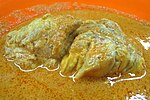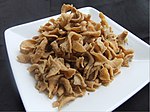Offal
Offal (/ˈɒfəl, ˈɔːfəl/), also called variety meats, pluck or organ meats, is the internal organs of a butchered animal. The word does not refer to a particular list of edible organs, and these lists of organs vary with culture and region, but usually exclude skeletal muscle. Offal may also refer to the by-products of milled grains, such as corn or wheat.[1]
Some cultures strongly consider offal consumption to be taboo, while others use it as part of their everyday food or, in many instances, as delicacies. Certain offal dishes—including foie gras and pâté—are often regarded as gourmet food in the culinary arts. Others remain part of traditional regional cuisine and are consumed especially during holidays; some examples are sweetbread, Jewish chopped liver, Scottish haggis, U.S. chitterlings, and Mexican menudo. On the other hand, intestines are traditionally used as casing for sausages.
Depending on the context, offal may refer only to those parts of an animal carcass discarded after butchering or skinning; offal not used directly for human or animal consumption is often processed in a rendering plant, producing material that is used for fertilizer or fuel; or in some cases, it may be added to commercially produced pet food. In earlier times, mobs sometimes threw offal and other rubbish at condemned criminals as a show of public disapproval.[2]
The offal of certain animals is unsafe to consume:




